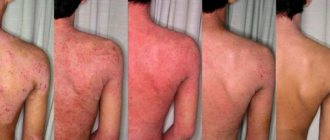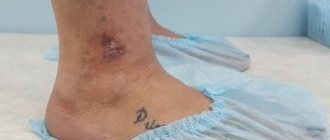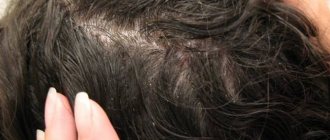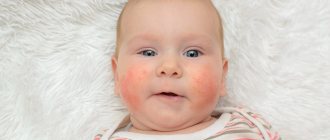Atopic dermatitis (AD) is a genetically determined chronic skin disease. It occurs as a result of exposure to various pathogenic factors (for example, physical or chemical) on the body. It is accompanied by pronounced itching and the presence of papular and urtricarial elements (specific swelling of the skin papillae). Atopy in this case is the hereditary predisposition of the body to allergies in response to certain irritants.
In fact, dermatitis is the most common allergic disease in both children and adults. In the world, the number of patients with allergic dermatitis increases every year.
Blood pressure most often appears in the first year of life. In children, the success of treatment and the ease of the disease depend on the persistence of the parents and the effectiveness of the prescribed drugs [1].
What it is?
Atopic dermatitis (AD) is an allergic skin disease that usually occurs in early childhood in people with a hereditary predisposition to atopic diseases, has a chronic relapsing course, age-related features of the localization and morphology of inflammation, characterized by skin itching and caused by hypersensitivity to both allergens and non-specific irritants.
The problem of AD is becoming increasingly important in modern medicine. The increase in incidence in the last 10 years, the chronic course of the disease with frequent relapses, and the insufficient effectiveness of existing methods of treatment and prevention make this disease one of the most pressing medical problems.
Atopic dermatitis is largely classified as a childhood disease, since its symptoms manifest in childhood.
The manifestation of AD symptoms in children is observed at the age of:
- 6 months in 50-60% of cases;
- up to 1 year in 75% of cases;
- up to 7 years - in 80-85% of cases (according to various authors).
Among the adult population in developed countries, AD occurs in 0.2-2% (5.9% in Russia). Over the past decades, there has been a significant increase in AD, its course becomes more complicated, and its outcome is aggravated.
AD is often combined with other allergic diseases:
- in 40% - with bronchial asthma;
- in 25% of cases – with allergic rhinitis;
- in 8% of cases – with hay fever.
Risk factors for developing atopic dermatitis
internal non-immunological, immunological
- heredity burdened with allergies;
- high intrauterine sensitization of the fetus associated with the pathology of pregnancy and childbirth;
- early artificial feeding;
- pathology of the gastrointestinal tract;
- intestinal dysbiosis from birth;
- frequent ARVI;
- the presence of foci of chronic infection;
- factors causing dry skin (impaired sweating, lack of interstitial fluid), changes in skin lipids, decreased itching threshold;
external
- exposure to reactive chemical compounds, food antigens, microorganisms, stressful situations, climatic conditions.
Trigger factors (provoking factors)
- Food product (usually cow's milk protein, egg, cereals, soy fish)
- Inhalation allergens (house dust, house dust mites, plant pollen). Microorganisms (St. aureus, V. Herpes, Malasseria furfur, especially Malasseria spp. and other mold fungi.)
Irritants
- Sex hormones
- Stress
- Climatic factors
The development of sensitization to these allergens occurs when they enter through the respiratory tract, gastrointestinal tract, or contact route (through the skin) and leads to the appearance of respiratory manifestations of atopy, such as allergic rhinitis and bronchial asthma. In more than 80% of patients, AD is associated with allergic rhinitis and in 30%-40% with bronchial asthma. In older children, food sensitization transforms into sensitization to aeroallergens:
Skin changes in AD are that with allergic inflammation, the skin of patients has a number of features and is characterized by:
- nonspecific hyperactivity to various stimuli and antigens;
- increased dryness;
- disorders of ceramide biosynthesis;
- increased physiological desquamation of the epithelium;
- thickening of the stratum corneum with the development of hyperkeratosis and pronounced peeling.
- Intense itching and scratching of the skin in combination with its hyperreactivity and a lower sensitivity threshold for itching determine the presence of a vicious circle: dry skin, itchy skin, inflammation.
Classification of AD
- Exogenous (allergic) AD associated with respiratory allergies and sensitization to aeroallergens. The risk of developing respiratory allergies in patients suffering from AD, according to various authors, ranges from 30 to 80%. 60% of AD patients have a latent tendency to develop bronchial asthma, and 30-40% develop it;
- Endogenous (non-allergic) AD, not associated with respiratory allergies and sensitization to any allergens.
Stages of the disease:
Age period:
- I age period – infant (up to 2 years)
- II age period – children (from 2 to 13 years)
- III age period – adolescence and adulthood (over 13 years old)
Stages of the disease:
- Exacerbation stage Phase of pronounced clinical manifestations
- Phase of moderate clinical manifestations
- Incomplete remission
Complications
- pyoderma;
- viral infection;
- fungal infection
Severity of the process
- mild course
- moderate severity
- severe course
Symptoms that require you to contact an allergist-immunologist
Main clinical signs of atopic dermatitis
- itchy skin;
- typical morphology and location of the rash according to the age period;
- tendency towards a chronic relapsing course;
- personal or family history of atopic disease;
- seasonality of exacerbation (deterioration in the cold season and improvement in summer);
- exacerbation of the process under the influence of provoking factors (allergens, irritants, foods, emotional stress); - connection between exacerbations and exposure to allergens;
- dry skin;
- white dermographism;
- tendency to skin infections;
- cheilitis (seed);
- Denny-Morgan sign (additional fold of the lower eyelid);
- hyperpigmentation of the periorbital area (around the eyes);
- increased levels of total and allergen-specific IgE in serum;
- peripheral blood eosinophilia.
Age characteristics and localization of skin lesions
| age periods | morphological characteristics | localization |
| infant (up to 2 years) | The predominance of the exudative form of blood pressure Inflammation is acute or subacute in nature Hyperemia, swelling, weeping, crusts are present | Face, outer surface of the legs, flexion and extension surfaces of the extremities. By the end of the period, the lesions are localized mainly in the area of the elbows and popliteal fossae, in the area of the wrists and neck. |
| children's (2-13 years) | The process is in the nature of chronic inflammation: erythema, papules, multiple peeling, thickening of the skin (infiltration), increased skin pattern (lichenization), multiple excoriations (scratching), cracks. At the sites where the rash resolves, there are areas of hypo- or hyperpigmentation. Possible Denny-Moran sign | Elbow and popliteal folds, back of the neck, flexor surfaces of the ankle and wrist joints, behind the ears |
| teenage and adult (from 13 and from 18 years old) | The phenomena of infiltration with lichenification predominate; erythema has a bluish tint. Papules merge into foci of continuous papular infiltration. | Upper body, face, neck, upper limbs |
The doctor evaluates
- the nature of the rashes and their correspondence to the age period
- presence or absence of scratching (intensity of skin itching)
- additionally, if any, symptoms of allergic rhinitis, allergic conjunctivitis, bronchial asthma
After which laboratory tests are prescribed to confirm the diagnosis.
Laboratory and instrumental studies
- Clinical blood test
- Determination of the concentration of total IgE in blood serum
- Skin tests with allergens to detect an IgE-mediated reaction
- Provocative test with food allergens
- determination of allergen-specific IgE-AT in blood serum
In addition, a general clinical examination is carried out, for example, 80-90% of patients have concomitant pathology of the digestive system. It has long been noticed that if there are several sources of the inflammatory process in the body, they “warm up” and increase the severity of each other. Therefore, after treating the concomitant pathology, the inflammatory process on the skin subsides and we need much less time and the amount of drugs used to stop it completely.
In light of all of the above, it is quite logical to additionally assign such studies:
- clinical and biochemical blood test
- general urine analysis
- coproocystoscopy
- bacteriological examination of feces
- esophagogastoduodenoscopy
- detection of Helicobacter pylori using a breath test
- Ultrasound of the abdominal organs
- X-ray examination of the chest and paranasal sinuses
- FVD assessment
- immunological examination (all immunoglobulins, possible selective deficiency of IgA, which often accompanies AD)
Specialist consultations:
- dermatologist - to establish a diagnosis, carry out differential diagnosis with other skin diseases, select and correct local therapy, and educate the patient.
- repeat consultation - in case of poor response to local glucocorticosteroid therapy or secondary infection.
- nutritionist – to create and correct an individual diet
- ENT – identification and sanitation of foci of chronic infection, early detection of AR symptoms
- neuropsychiatrist - for severe itching, behavioral disorders, psychotherapeutic treatment, training in relaxation techniques, stress relief and behavior modification.
How to deal with eczema?
This is far from an easy task. Indeed, despite the fact that all types of eczema develop approximately according to the same scenario, the triggering factors in each case are completely different.
You must understand that in order to successfully combat the disease, it is advisable to identify and eliminate them. And if the wound heals, and mycosis can be successfully treated, then it is already more difficult to eliminate advanced varicose veins. But it is generally beyond our power to grow a new limb in place of a stump or change the genetic constitution.
Therefore, the battle with eczema is a long process that requires constant interaction between the patient and the doctor and constant work to follow the recommendations (diet, regimen, skin care).
You must be prepared for the fact that even if you have the most competent doctor and carefully follow all the advice, exacerbations will still occur from time to time. After all, we cannot influence all provoking factors.
The main thing to remember is that everything passes, and this exacerbation will pass. The main thing is to maintain a calm and positive attitude, since stress is the primary provocateur of all illnesses.
Some recommendations
Nutrition for eczema
Eczema is an allergic disease, so following a hypoallergenic diet is one of the most important points in the fight against the disease.
Naturally, not every person suffering from eczema has intolerance to all those foods that are recommended to be excluded from the diet.
Dietary restrictions are based on the fact that many foods, simply by virtue of their composition, are capable of provoking and maintaining the inflammatory process. For example, histamine is formed in sea fish when frozen. This is exactly the substance to which we owe burning, itching, redness and swelling during allergic reactions.
Rational skin care
We all know that we must observe personal hygiene measures, keep ourselves clean, etc.
However, among northern peoples who live in harmony with nature, but do not have the habit of taking a hot shower every day, eczema does not occur.
Healthy skin is covered with a protective water-fat mantle. This peculiar film has a certain composition, a slightly acidic reaction and is inhabited by our “native” microorganisms. All this, together with the stratum corneum of the epidermis, prevents excess moisture loss and protects against the penetration of unwanted substances and creatures into the skin.
It has been proven that after intensive washing in hot water with soap and a washcloth, protective mania is restored within 24 hours. Accordingly, if you wash with fanaticism, even a healthy person can be driven to eczema.
If eczema has already occurred, then the skin barrier is already broken. Therefore, water procedures are generally prohibited in the acute stage, and limited in the chronic stage.
The skin of a patient with eczema is constantly in a state of combat readiness to respond with inflammation to minor irritation. Therefore, the water should be warm (37 - 38 °C), the sponge should be soft, the soap should be thin (and preferably not alkaline), and the towel should be fluffy. After washing, the skin should not be rubbed, but blotted.
To restore the barrier and stop water loss through the skin, emollients (moisturizers) are always included in the eczema treatment complex. These are preparations in the form of milk or cream that have a specially selected composition and do not contain fragrances, dyes or preservatives (so as not to provoke an allergic reaction). At this stage, the choice of such products in pharmacies is very wide.
If the skin of the hands is affected
The skin of the hands receives the maximum number of harmful effects, so hand eczema is one of the most common manifestations, especially in women.
Some useful tips for this case:
- Wash your hands with water at room temperature using a soap substitute. It is advisable to exclude soap.
- Avoid direct contact with irritating substances (household chemicals, solvents, fuels and lubricants), and with the ground. If possible, with shampoo when washing your hair (wash your hair with plastic gloves).
- Do not wear rings as liquids and detergents will accumulate underneath them.
- Avoid latex gloves (many people are allergic to it). You can use polyethylene, polyvinyl chloride, nitrile gloves.
- Do not use gloves with talc - it dries out and irritates the skin.
- Do not wear gloves for more than 20 minutes without a break. You can wear cotton gloves under protective gloves.
- In cold weather, be sure to wear mittens or gloves outside to prevent chapped skin.
These recommendations should be followed for at least 6 months after the symptoms of eczema disappear, since skin resistance is not restored immediately.
Adequate sleep and rational physical activity
Eczema is a dermatosis in which there are disorders of both the nervous and vascular systems. It is impossible to organize their work if a person is overtired and stressed.
Main goals and directions of therapy
AD is a chronic disease, so treatment should be gradual and long-term.
- Elimination of causally significant allergens with the prescription of diet therapy and control of adverse environmental factors;
- Elimination or reduction of inflammatory changes on the skin and skin itching.
- Restoring the structure and function of the skin (improving microcirculation and metabolism in lesions; normalizing skin moisture).
- Prevention of the development of severe forms of the disease, leading to a decrease in the quality of life of patients and their disability.
- AD is based on allergic inflammation, so the basis of treatment is antihistamines and anti-inflammatory drugs.
- Multiple organ lesions in AD require systemic basic therapy with antiallergic drugs.
- Identification and treatment of concomitant diseases that aggravate the course of AD. (treatment of pathologies of the digestive system, metabolite and antioxidant therapy, normalization of functional disorders of the nervous system, rehabilitation of foci of chronic infection).
Areas of AD therapy:
- diet therapy and elimination measures to eliminate causally significant allergens;
- systemic pharmacotherapy;
- antihistamines;
- membrane stabilizing drugs;
- drugs that normalize the functions of the digestive system;
- vitamins;
- immunomodulators;
- drugs that regulate the function of the ANS;
- preparations containing unsaturated fatty acids;
- antibiotics;
- systemic corticosteroids (for special indications);
- External therapy and rehabilitation.
Correction of immune disorders in AD
- Direct methods of immunocorrection are allergen-specific immunotherapy (ASIT), therapeutic plasmapheresis, and immunopharmacotherapy itself with corrective drugs, as well as the use of modern immunosuppressants.
- ASIT is the only method of therapeutic influence on all pathogenetically significant parts of the allergic process, which has a long-term preventive effect and allows for the reverse development of the pathological process, because at the same time, a decrease in nonspecific tissue sensitivity to the allergen is formed, hyperreactivity decreases, and signs of allergic inflammation are suppressed, which indicates a restructuring of the nature of the cellular and cytokine response from Th2 to Th1 - a response with a decrease in the content and production of Ig E.
Indications for ASIT are determined by a set of criteria:
- diffuse or widespread form of AD;
- moderate/severe;
- clinically significant sensitization to aeroallergens, confirmed on the basis of anamnesis, positive skin tests and/or detection of specific Ig E antibodies to a given allergen;
- hereditary burden of allergic diseases, especially respiratory allergies;
- hypersensitivity to one group of allergens.
Advantages of treating atopic dermatitis in our clinic:
- Comprehensive examination on the day of treatment
- Start of treatment on the day of treatment
- Quick relief (1-3 days)
- Individual patient education (immuno-school, asthma school).
- Return to a full life
Atopic dermatitis is a very common disease that is allergic in nature. Many patients suffering from dermatitis neglect treatment, believing that the disease will go away on its own. This misconception leads to disruption of the skin barrier functions, infection and aggravation of the process. If you contact a specialist allergist-immunologist in a timely manner, such consequences can be avoided.
Atopic dermatitis (AD) is an allergic skin disease that usually occurs in early childhood in people with a hereditary predisposition to atopic diseases, has a chronic relapsing course, age-related features of the localization and morphology of inflammation, characterized by skin itching and caused by hypersensitivity to both allergens and non-specific irritants.
The problem of AD is becoming increasingly important in modern medicine. The increase in incidence in the last 10 years, the chronic course of the disease with frequent relapses, and the insufficient effectiveness of existing methods of treatment and prevention make this disease one of the most pressing medical problems.
Atopic dermatitis is largely considered a childhood disease because its symptoms often first appear in childhood.
The manifestation of symptoms of atopic dermatitis in children is observed at the age of:
- up to 6 months in 50-60% of cases;
- up to 1 year - in 75% of cases;
- up to 7 years - in 80-85% of cases (according to various authors).
Atopic dermatitis in adults occurs in 0.2-2% (in Russia 5.9%) of the population. Over the past decades, there has been a significant increase in cases of dermatitis, its course is becoming more complicated, and its outcome is aggravated.
AD is often combined with other allergic diseases:
- in 40% - with bronchial asthma;
- in 25% of cases – with allergic rhinitis;
- in 8% of cases – with hay fever.
Make an appointment with a dermatologist
Our specialists know how to treat atopic dermatitis even in the most complex clinical cases. Extensive experience combined with an individual approach provides the most effective results, which you can find in the corresponding section on the website.
Remember that it is important to start treatment as early as possible. Make an appointment with a dermatologist right now, without putting it off until tomorrow. Contact us through the form on the website or by contact numbers +7 (495) 150-15-14,.
Risk factors for developing atopic dermatitis
Among the internal risk factors, non-immunological and immunological are distinguished:
- heredity burdened with allergies;
- high intrauterine sensitization of the fetus associated with the pathology of pregnancy and childbirth;
- early artificial feeding;
- pathology of the gastrointestinal tract;
- intestinal dysbiosis from birth;
- frequent ARVI;
- the presence of foci of chronic infection;
- factors causing dry skin (impaired sweating, lack of interstitial fluid), changes in skin lipids, decreased itching threshold.
External factors include the impact of reactive chemical compounds, food antigens, microorganisms, stressful situations, and climatic conditions.
Trigger factors are also identified , that is, conditions that provoke the development of atopic dermatitis:
- food products (usually cow's milk protein, eggs, cereals, soybeans, fish);
- inhalation allergens (house dust, house dust mites, plant pollen);
- microorganisms (St. aureus, V. Herpes, Malasseria furfur);
- Malasseria spp. and other molds.
Irritating substances also have some influence on the manifestation of atopic dermatitis:
- sex hormones;
- stress;
- climatic factors.
The development of sensitization to these allergens occurs when they enter through the respiratory and/or gastrointestinal tract, as well as through contact through the skin. This leads to the appearance of respiratory manifestations of atopy, such as allergic rhinitis and bronchial asthma. In more than 80% of patients, dermatitis is associated with allergic rhinitis and in 30-40% with bronchial asthma. In older children, food sensitization transforms into sensitization to aeroallergens.
Skin changes with atopic dermatitis are as follows:
- characteristic nonspecific hyperactivity to various stimuli and antigens;
- characterized by increased dryness;
- there are disturbances in the biosynthesis of ceramides;
- increased physiological desquamation of the epithelium;
- thickening of the stratum corneum with the development of hyperkeratosis and severe peeling.
Intense itching and scratching of the skin in combination with its hyperactivity and a lower sensitivity threshold determine the presence of a vicious circle - dry skin - itchy skin - inflammation.
Classification of atopic dermatitis
- Exogenous (allergic) dermatitis - associated with respiratory allergies and sensitization to aeroallergens. The risk of developing respiratory allergies in patients suffering from AD, according to various authors, ranges from 30 to 80%. 60% of AD patients have a latent tendency to develop bronchial asthma, and 30-40% develop it.
- Endogenous (non-allergic) atopic dermatitis, not associated with respiratory allergies and sensitization to any allergens.
Stages of the disease:
- Exacerbation stage
- Phase of pronounced clinical manifestations
- Phase of moderate clinical manifestations
- Incomplete remission
- Complete remission
Complications of atopic dermatitis:
- pyoderma;
- viral infection;
- fungal infection.
Severity of the process:
- mild course;
- moderate severity;
- severe course.
Diaper dermatitis in children - how to treat the little ones?
One of the most common and early ailments in a child under 1 year of age is atopic diaper dermatitis. Irritation appears on the butt and in the groin area - that is, in places that come into contact with diapers or diapers. Most often, diaper dermatitis occurs when diapers are not changed on time. The skin cannot breathe, plus it is affected by aggressive substances from excretory products. This is how swelling, peeling, redness and itching appear. The best remedy for diaper dermatitis is to give your baby air baths, wash him more often, use powders for weeping irritations and creams for dry ones.
Symptoms of atopic dermatitis
- itchy skin;
- typical morphology and location of the rash according to the age period;
- tendency towards a chronic relapsing course;
- personal or family history of atopic disease;
- seasonality of exacerbation (deterioration in the cold season and improvement in summer);
- exacerbation of the process under the influence of provoking factors (allergens, irritants, foods, emotional stress);
- the presence of a clear connection between exacerbations and exposure to allergens;
- dry skin;
- white dermographism;
- tendency to skin infections;
- cheilitis (jamming) in the corners of the lips;
- Denny-Morgan sign (additional fold of the lower eyelid);
- hyperpigmentation of the periorbital area (around the eyes);
- increased levels of total and allergen-specific IgE in serum;
- peripheral blood eosinophilia.
| Age periods | Morphological characteristics of symptoms | Localization of manifestations |
| Infancy (up to 2 years) | The predominance of the exudative form of atopic dermatitis. The inflammation is acute or subacute. There is hyperemia, swelling and weeping crusts. | Face, outer surface of the legs, flexor and extension surfaces of the limbs. By the end of the period, the lesions are localized mainly in the elbow bends and popliteal fossae, in the wrists and neck. |
| Children's age (2-13 years) | The process is in the nature of chronic inflammation. Dermatitis is characterized by the presence of erythema, papules, multiple desquamation, thickening of the skin (infiltration), increased skin pattern (lichenification), multiple excoriations (scratching) and cracks. At the sites where the rash resolves, there are areas of hypo- or hyperpigmentation. Possible Denny-Moran sign. | Elbow and popliteal folds, back of the neck, flexor surfaces of the ankle and wrist joints, behind the ears. |
| Adolescence and adulthood (from 13 and from 18 years old) | The phenomena of infiltration with lichenification predominate; erythema has a bluish tint. Papules merge into foci of continuous papular infiltration. | Upper half of the body, face, neck, upper limbs. |
Diagnosis of atopic dermatitis
During the initial examination, the doctor assesses:
- the nature of the rashes and their correspondence to the age period;
- presence or absence of scratching (intensity of skin itching);
- additionally, if any, symptoms of allergic rhinitis, allergic conjunctivitis, bronchial asthma.
After consulting a specialist, laboratory tests are prescribed to confirm the diagnosis.
Laboratory and instrumental studies:
- clinical blood test;
- determination of the concentration of total IgE in blood serum;
- skin tests with allergens to detect an IgE-mediated reaction;
- provocative test with food allergens;
- determination of allergen-specific antibodies to IgE in blood serum.
In addition, a general clinical examination is carried out. For example, 80-90% of patients have concomitant pathology of the digestive system. It has long been noticed that if there are several sources of the inflammatory process in the body, they “warm up” and increase the severity of each other. Therefore, after treating the concomitant pathology, the inflammatory process on the skin subsides and the specialist needs much less time and the amount of drugs used in order to stop it completely.
In light of all of the above, it is quite logical to prescribe additionally the following series of studies :
- clinical and biochemical blood test;
- general urine analysis;
- coproocystoscopy;
- bacteriological examination of feces;
- esophagogastoduodenoscopy;
- detection of Helicobacter pylori using a breath test;
- Ultrasound of the abdominal organs;
- X-ray examination of the chest and paranasal sinuses;
- assessment of physical function;
- immunological examination (all immunoglobulins, selective IgA deficiency is possible, which often accompanies atopic dermatitis).
It is also recommended to undergo examination by specialists:
- dermatologist - to establish a diagnosis, carry out differential diagnosis with other skin diseases, select and correct local therapy, and educate the patient.
- repeat consultation - in case of poor response to local glucocorticosteroid therapy or secondary infection.
- nutritionist – to create and correct an individual diet
- ENT – identification and sanitation of foci of chronic infection, early detection of symptoms of allergic rhinitis.
- neuropsychiatrist - for severe itching, behavioral disorders, psychotherapeutic treatment, training in relaxation techniques, stress relief and behavior modification.
Prevention of eczematous (allergic contact) dermatitis
Compliance with preventive measures will help prevent the development of the disease:
- Avoid metal jewelry that can cause allergic reactions.
- Use household chemicals or potent substances only with gloves.
- Selection of cosmetics taking into account the characteristics of the skin, with the most natural ingredients;
- In case of allergic reactions, avoid contact with known allergens.
- Observe personal hygiene rules.
To ease the course of the disease you should:
- After taking a shower or bath, wipe your skin dry.
- Apply bandages to areas of skin affected by dermatitis.
- Do not interrupt the prescribed treatment regimen.
By following practical advice and doctor’s instructions, treatment will go faster and the possibility of relapse will decrease.
Treatment of atopic dermatitis
Dermatitis is a chronic disease, so treatment should be gradual and long-term :
- Elimination of causally significant allergens with the prescription of diet therapy and control of adverse environmental factors;
- Elimination or reduction of inflammatory changes on the skin and skin itching.
- Restoring the structure and functions of the skin (improving microcirculation and metabolism in lesions, normalizing skin moisture).
- Prevention of the development of severe forms of the disease, leading to a decrease in the quality of life of patients and their disability.
- The disease is based on allergic inflammation, so the basis for the treatment of atopic dermatitis is antihistamines and anti-inflammatory drugs.
- The multiorgan nature of lesions in AD requires systemic basic therapy with antiallergic drugs.
- Identification and treatment of concomitant diseases aggravating the course of AD. For example, treatment of pathologies of the digestive system, metabolite and antioxidant therapy, normalization of functional disorders of the nervous system, sanitation of foci of chronic infection.
Directions for treatment of atopic dermatitis:
- diet and elimination measures to eliminate causally significant allergens;
- systemic pharmacotherapy;
- antihistamines;
- membrane stabilizing drugs;
- drugs that normalize the functions of the digestive system;
- vitamins;
- immunomodulators;
- drugs that regulate the function of the ANS;
- preparations containing unsaturated fatty acids;
- antibiotics;
- systemic corticosteroids (for special indications);
- external therapy and rehabilitation.
Correction of immune disorders in AD. Direct methods of immunocorrection are:
- allergen-specific immunotherapy (ASIT);
- therapeutic plasmapheresis;
- immunopharmacotherapy with corrective drugs, as well as the use of modern immunosuppressants.
ASIT is the only method of therapeutic influence on all pathogenetically significant parts of the allergic process, which has a long-term preventive effect and allows for the reverse development of the pathological process. In this case, a decrease in nonspecific tissue sensitivity to the allergen is formed, hyperreactivity decreases, and signs of allergic inflammation are suppressed, which indicates a restructuring of the nature of the cellular and cytokine response from Th2 to Th1 - a response with a decrease in the content and production of Ig E.
Indications for ASIT are determined by a set of criteria:
- diffuse or widespread form of AD;
- moderate/severe dermatitis;
- clinically significant sensitization to aeroallergens, confirmed on the basis of anamnesis, positive skin tests and/or detection of specific Ig E antibodies to a given allergen;
- hereditary burden of allergic diseases, especially respiratory allergies;
- hypersensitivity to one group of allergens.
Clinical researches
La-Cri creams for sensitive skin and La-Cri cream for dry skin are recommended by the St. Petersburg branch of the Union of Pediatricians of Russia.
The conducted clinical study proves the high efficiency, safety and tolerability of the product for daily skin care of children with mild and moderate forms of atopic dermatitis and during remission, accompanied by a decrease in the quality of life of patients. As a result of therapy, a decrease in the activity of the inflammatory process, a decrease in dryness, itching and flaking was noted.
Sources:
- B.A. Shamov, I.G. Safiullina, A.B. Beshimova, T.B. Shamov, Differential diagnosis of atopic dermatitis, journal of Practical Medicine, 2011 https://cyberleninka.ru/article/v/differentsialnaya-diagnostika-atopicheskogo-dermatita
- Fokina R.A., Atopic dermatitis: stages of development of classification forms, Siberian Medical Journal, 2007 https://cyberleninka.ru/article/v/atopicheskiy-dermatit-etapy-razvitiya-klassifikatsionnyh-form
- Smirnova G.I. Atopic dermatitis and skin infections in children, Russian pediatric journal, 2014 https://cyberleninka.ru/article/v/atopicheskiy-dermatit-i-infektsii-kozhi-u-detey
Photos of dermatitis
Photo album on the disease








